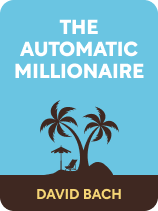

This article is an excerpt from the Shortform book guide to "The Automatic Millionaire" by David Bach. Shortform has the world's best summaries and analyses of books you should be reading.
Like this article? Sign up for a free trial here .
How do you plan to save for your retirement? What should you do if your employer doesn’t offer a retirement plan?
Saving for retirement is essential if you want to live comfortably in your golden years. If your company offers a self-directed retirement account, make sure you sign up to benefit from it (automatic enrollment is not always offered). If your company doesn’t offer self-directed retirement accounts, you’ll need to open an Individual Retirement Account (IRA).
In this article, we’ll look at how to save for retirement with employer-offered and self-directed retirement accounts. We’ll also look at how you can automate your retirement plan so that you can relax knowing that you’ve prepared yourself for a prosperous future.
If Your Employer Offers Self-Directed Retirement Accounts
There are two types of self-directed retirement accounts your employer might offer: 401(k) and 403(b). Both plans offer the following benefits:
- Your payroll department can arrange automatic contributions to your retirement account.
- (Shortform note: While it’s convenient that your payroll department can manage this for you, Bach doesn’t mention the high fees you’ll end up paying in this type of system (and may not be aware of). You’ll end up paying numerous administration, investment, and service fees every time you contribute.)
- Your employer may offer to contribute towards your retirement plan. Many employers agree to top up your contributions based on a percentage amount of what you’re already contributing. So, if your employer agrees to pay 25% of your contribution, they’ll top up your account with 25 cents for each dollar you contribute.
- (Shortform note: The more your employer contributes, the more you pay to take advantage of the plan. This is because the fees you pay to use the plan are calculated as a percentage of your total contribution. So if you contribute $100, and your employer tops up your contribution with $50, your fee will be based on a percentage amount of $150.)
- You don’t pay tax on the money you contribute to your retirement plan or on any of the compound interest that you earn over the course of your plan—you only pay taxes once you start taking the money out of your retirement account.
- (Shortform note: While you’ll benefit from the immediate advantages of paying less tax now so that you can save more for the future, this plan may end up costing you more if you plan to withdraw large amounts after you retire. This is because your withdrawals will count as taxable income—the more you withdraw, the more tax you’ll pay.)
- You can contribute up to $18,000 a year if you’re under the age of 50, and $24,000 a year if you’re over the age of 50.
- (Shortform note: Your employer’s contributions to your plan do not count towards these limits. You can contribute $18,000 towards your plan (if you’re under the age of 50) regardless of whether or not your employer matches your contribution.)
One out of every four American workers don’t sign up for their retirement accounts—most people just assume that they’re automatically signed up to benefit from their company’s retirement plan. While some companies do offer automatic enrollment, you still need to check what percentage of pay you’re contributing towards your retirement plan. Bach explains that the companies that offer automatic enrollment tend to set your contributions at a very low rate, between 1-4%.
(Shortform note: Bach mentions that people often don’t enroll in their company’s retirement plans, but he doesn’t offer in-depth explanations for why this reluctance exists. According to some psychologists, one reason we avoid planning for our retirement is that we find it difficult to imagine ourselves getting older—while we understand that old age is inevitable, the concept doesn’t feel real. As a result, we’re more inclined to seek gratification here and now than save for our future needs.)
How to Automate It
If you’re not enrolled in your company’s retirement plan:
- Ask your company for the retirement account sign up forms.
- Decide how much you’re going to contribute to your pension every time you get paid—choose a percentage of your pay rather than a specific dollar amount as this will ensure your contributions increase whenever you get a pay rise. Contribute what you can but aim for at least 10% of your pay.
If you’re already enrolled in your company’s retirement plan:
- Check your plan to see how much you’re contributing.
- Increase your contributions as much as possible—aim to reach the maximum amount that your company allows.
| Factors That Impact Your Retirement Plan Bach instructs you to implement these steps to set up and automate your retirement accounts before you work on automating the rest of your finances. However, it may be worth walking through the rest of Bach’s ideas before you finalize your decisions about your retirement plan for the following reasons: You may decide to opt for an IRA to avoid paying taxes on your withdrawals (we cover IRA accounts in the next section).You need to set up investment options so that your retirement fund can grow (chapter 3).You may decide to change the percentage of your retirement contributions if you have debts. Reading through the entire guide will ensure that you make informed decisions about your retirement plan. |
If You Need to Open an Individual Retirement Account
If your employer doesn’t offer self-directed retirement accounts, you’ll need to open an Individual Retirement Account (IRA). You can choose from one of three options: the Traditional IRA, the Roth IRA, or the Roth 401(k), which is similar to the Roth IRA but allows you to contribute more each year. The difference between the Traditional IRA and the Roth IRAs is when you pay tax on your retirement money: when you withdraw money in the case of the Traditional IRA, and when you contribute in the case of the Roth IRAs. This means that the Traditional IRA has the benefit of allowing you to contribute more money upfront, as it won’t be taxed; meanwhile, the Roth IRAs provide tax-free income after you retire.
In his book The Automatic Millionaire, Bach gives the following advice on how to save for retirement with an individual account: if you’re at least 15 years away from your retirement, the Roth IRA is the most beneficial option for you—you’ll pay your tax for your contributions during these 15 years but benefit from tax-free withdrawals for the rest of your life.
| Additional Retirement Account Options The three IRA accounts Bach mentions are standard options for people who need to open up their own retirement accounts. They’re recommended in a number of financial books including I Will Teach You to Be Rich and The Simple Path to Wealth. However, Bach doesn’t mention additional options you may want to consider. In The Simple Path to Wealth, J.L. Collins suggests Thrift Saving Plans as an option. These plans have extremely low fees and are aimed at federal employees, including members of the military. In addition, if you’re on a low to moderate income, you may be able to take advantage of the Saver’s Credit. This option offers additional benefits beyond tax-deferred savings because it offers tax deductions based on your income and circumstances. If you qualify, you’ll receive a tax credit for the first $2,000 you contribute each year. |
How to Open an IRA Account
You can choose to open your IRA account through a bank, a brokerage firm, a mutual fund company, or an online investment firm. To set this up quickly and efficiently, Bach recommends you choose from one of the following online investor firms:
If you’d prefer to speak to a financial advisor face to face, Bach provides information for full-service brokerage firms and banks that are more likely to have local branches near you:
- Ameriprise Financial
- Citi Personal Wealth Management
- Edward Jones
- Lincoln Financial
- Merrill Lynch
- Morgan Stanley
- Raymond James
- T. Rowe Price
- UBS
- Wells Fargo Advisors
| The Difference Between Free and Paid IRA Accounts Both Bach’s and Sethi’s recommendations for banks and brokerage firms hinge on the discounts or perks you receive—for example, free accounts and small minimum investment fees. Like Bach, Sethi also recommends that you use Vanguard, Charles Schwab, or Fidelity—established firms with a good reputation. However, keep in mind that these accounts tend to be free because they require more of a do-it-yourself approach: You need to do the research about what options are available and decide what suits your lifestyle before you sign up with them. If you require a more personalized service—one that’s tailored to your specific needs—you’ll need to pay management fees that will eat into your contributions. So, before making a choice, consider realistically how involved you want to be with your plan and shop around for the bank or brokerage firm that best suits your needs. |
How to Automate It
Once you’ve chosen your IRA plan, make sure you set up a systematic investment plan so that your money is automatically transferred into your IRA account. You can ask your employer if they can transfer the money automatically to your IRA, or you can arrange a direct debit from your checking account(you’ll need to fill out an ACH debit authorization form to authorize this). You can also use an online bill payment service, such as PayTrust, to manage these payments for you, but you will need to pay fees for this service.
(Shortform note: While systematic investment plans do offer many advantages—most notably, that automated payments require zero discipline—there are disadvantages for those who have unpredictable earnings, such as freelancers or small business owners. It’s difficult to automate your payments if you don’t know how much you’ll be earning from month to month. If you instruct your bank to send money that you don’t have, you could end up with extra overdraft fees. So, if you intend to use this plan, ensure that you always have the funds available to make your payments—it’s notoriously difficult to amend the payment dates once the plan’s in motion.)

———End of Preview———
Like what you just read? Read the rest of the world's best book summary and analysis of David Bach's "The Automatic Millionaire" at Shortform .
Here's what you'll find in our full The Automatic Millionaire summary :
- A simple but powerful action plan for you to quickly automate your finances
- How to grow your finances with just a few dollars a day
- An exploration of why people fail to prepare for their financial futures





